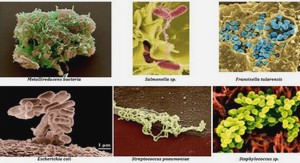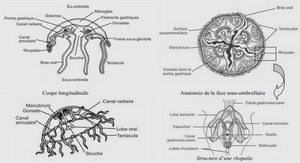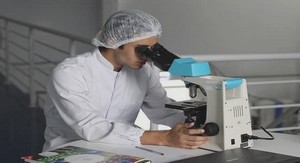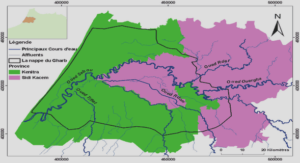Etude de traitement par plasma froid de surfaces contaminés par biofilms
Low-temperature plasma
Plasma is often called as the fourth state of matter and defined as a microscopically neutral ionised gas. It is constituted by particles in permanent interaction: the particles include photons and electrons (“light” species), positive and negative ions, atoms, free radicals and excited or non-excited molecules (“heavy” species). In order to study plasma in laboratory conditions one needs to generate it. In general, there are two ways of plasma generation. The first is to heat the gas to high temperature. Such a thermal plasma is characterized by an almost local thermodynamic equilibrium between the electrons and the heavy species; the gas temperature is nearly the same for all the components of the plasma and can be very high (5 to 20×103 K). The second method uses strong electric field between electrodes and less power, and typically generates non-thermal plasmas. These types of plasmas are usually generated by electrical discharges in low pressure gases. The electron temperature in non-thermal plasmas is much higher than that of the gas (heavy species), and consequently the plasma is not in a local thermodynamic equilibrium. An intermediate category between these two others without clearly defined limits, is a non-thermal plasma generated in near atmospheric pressure and ambient temperature. This type of plasma is especially interesting for applications in industry, medicine and research because it does not require extreme conditions. Typical example of such plasmas are the corona discharge, dielectric barrier discharges, plasma jets, and gliding arc discharge.
Discharge generation
Plasma generation by electrical discharges uses transition of an electric current through the gas by imposing the electric field. When two electrodes at the ends of a discharge chamber are supplied with the low voltage from DC voltage generator, low current can be detected (1015 A). It is carried by the primary electrons, which are generated by cosmic radiation, radioactivity, etc. The primary electrons accelerated by the increasing electric field are able to ionize atoms or molecules of the present gas and form other electrons. This process is repetitive, and the number of electrons is doubled in every ionization collision. An electron avalanche is thus generated. This creates an ionized gas between the electrodes, which is externally reflected by the increase in electric conductivity of the gas.
Discharges in gases
The electric discharge develops after reaching the breakdown between electrodes. The discharge characteristics depend on the gas pressure and composition, the shape of the electrodes and properties of the power supply. The breakdown voltage (Uz) of a gas is according to the Paschen’s law in homogeneous electric field a function of the pressure (p0 ) multiplied by the distance between electrodes. Self sustained conditions are reached when secondary emission supply mechanisms seed electrons from cathode. We distinguish several basics types of discharges: corona, arc, glow, dielectric barrier, and high frequency (radio or microwave) discharges.
Corona discharge
The corona discharge is a low-current gas discharge in which the geometry confines the ionization and the high electric field in the vicinity of electrode. A non-uniform high electric fields are formed when a radius of curvature at least one of the electrodes is far less than a length of the inter-electrode gap. One of typical corona configurations is point-to-plate geometry. According to the applied voltage shape, corona discharges can be direct current (DC), alternating current (AC), high frequency (HF) or pulsed corona discharges, or their combination. Coronas are divided according to the polarity of the active electrode, into negative, positive or bipolar corona. [44, 45] Positive corona starts with a glow corona regime (unipolar conduction corona), with the ionization region concentrated very close to the high field electrode. At a fixed voltage it operates quietly, with steady microampere and above currents carried by positive ions flowing through the drift region1 . The glow corona sometimes transits to the burst corona. This regime seldom exhibits and non-regular current pulses accompanied with a short and faint streamers originate from the high field electrode. By increasing the voltage the burst regime proceeds to the audio noisy streamer corona. In this regime, the ionization region produces a conducting plasma faster than it can be absorbed by the point electrode. A cloud of many accumulated positive ions induces a space charge and the electric field between its own front and the cathode, which is superior to the original electric field. This further enhances ionizations in front of the space charge. Consequently a conductive plasma filament grows out from the point towards the plane electrode, carrying the plasma producing ionization region ahead with a velocity around 106 m/s (values typical for air at atmospheric pressure). When the streamer hits the plane electrode, a cathode spot is produced, the gap electric 1Low field region connecting the ionization region with the low field, passive electrode. In the drift region, ions and electrons drift and react with neutrals, but have too low energy to ionize and too low density to react with other ionized particles. [44] 10 Chapter 2. Low-temperature plasma field is redistributed along the plasma channel, and this channel either dies out by electron attachment or later converts to a thermally ionized spark channel. The streamer corona discharge is electrically characterized by positive current pulses, around 10 mA amplitude, 100 ns duration, and ∼10 kHz repetition rate with DC applied voltage in air at atmospheric pressure. [44, 45] Negative corona, similarly to the positive corona starts with the ionization region concentrated near the high field electrode (cathode in this case). This regime is called Trichel pulse corona (unipolar conduction corona) after G. W. Trichel [46] who first studied this phenomenon. It is characterized by regular short (100–200 ns duration) current pulses (∼1 mA amplitude) with high repetition rate, a luminosity around the tip of the active electrode and a dark inter-electrode gap (drift region). The repetition rate of current pulses increases linearly with the applied voltage and ranges over 1–1000 kHz. Only the part of the drift region current is carried by electrons (below 10-20 µA total current), because of electron attachment (in electronegative gases). At higher currents, the space charges make the electric field distribution more uniform. This, and the higher applied voltage, sharply increase the drift region field, increasing the electron/negative ion ratio. The Trichel pulse corona is followed by a pulse-less negative glow corona as the applied voltage increases. In static air, if the voltage is progressively increased, this steady pulse-less corona transforms directly into a spark discharge.
Electrostatic spraying
The application of high voltage (several thousands volts) to a spray nozzle (capillary) can atomize various liquids into fine droplets. This process is called electrospray or EHD (electrohydrodynamic) spray. Fine droplet formation in an EHD spray is often explained by the balance between the repulsive electrostatic force and the restoring forces of the surface tension. Surface tension of liquids decreases under the influence of electrical potential. This is explained by the increased orientation of the water molecule dipoles in the surface layer, these dipoles repel one another, thus causing a reduction in surface energy. When the electrostatic force overcomes the surface tension of the liquid, electrically charged fine droplets are ejected from the cone (Taylor cone). However, the real process is greatly influenced by many parameters and these two forces cannot explain all the phenomena encountered in an electro-spray. According to the published literature, the parameters investigated in the electro-spray process include the type of liquid (its surface tension, conductivity, viscosity, density, relative permitivity), the nozzle diameter, the liquid flow rate, the applied voltage and its polarity, and so on. The size of liquid droplets varies from the millimeter to the submicrometre range according to the mode of electro-spray. [47, 48] 11 Chapter 2. Low-temperature plasma The electro-spray has been used in various applications such as generation of highly dispersed micro-and nanoparticles, ink-jet printing, paint spraying, fuel atomization, ion sources in mass spectrometry, agricultural treatment, surface coating, dust removal, drug inhalation etc. EHD sprays of polymer solutions can produce nanofibers, a process often referred to as electrospinning. Several different spray modes are observed, such as dripping, spindle, oscillating cone-jet, multi-jet, and stable cone-jet. [47, 48] The elecro-spray was also studied together with electrical discharges, especially with corona discharges [47–51] and glow discharge [52, 53]. Electro-spraying tap water (conductivity 0.6 mS.cm1) through the discharge can affect the space charge distribution in the discharge zone and electric field intensities at a liquid surface [53]. In more conductive liquids, the discharge could more likely take place from the liquid surface, which has almost the same potential as the electrode. In more insulating low-conductivity liquids, the discharge occurs more likely at the metal electrode tip [49]. Electrical discharges such as gliding arc [54], positive and negative corona discharges [18, 24], and transient spark [20, 55] together with electro-spray were used for bio-decontamination of surfaces and liquids. The electro-spray combined with corona discharges will be employed in this thesis as well.
Introduction |




